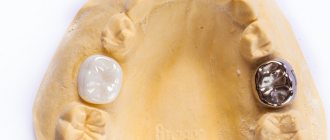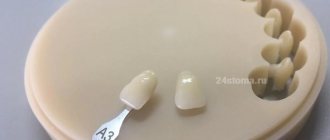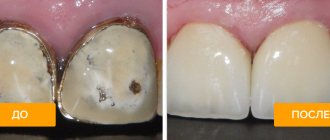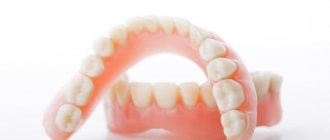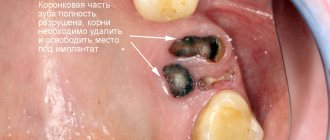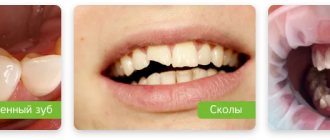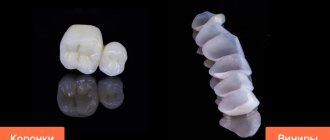Due to the rhythm of modern life, a corresponding imprint is left on a person’s health and appearance. One of the important factors of good health is strong and healthy teeth. But, unfortunately, not many can boast of this.
The product allows you to correct aesthetic imperfections
Special attention in dentistry is paid to dental prosthetics, especially if they are anterior and the aesthetic appearance depends on them. Plastic teeth have many advantages over others, but they are not suitable for everyone.
Peculiarities
The main difference between plastic teeth and others is their rapid production. Many are of the opinion that it is not worth using such a design, since there are a large number of shortcomings. In fact, the advantages outweigh almost all the disadvantages.
An example of what crowns look like
You can talk about the feasibility of plastic teeth after studying the characteristics of the structures:
- Not strong enough. Compared to ceramics, the product is less durable, which is why they are not installed on chewing teeth.
- The service life of the product depends on the strength of the material. Since plastic does not have sufficient strength, orthopedic structures made from it cannot last long.
- The finished product has a porous structure, due to the properties of the material.
Plastic teeth are most often installed by those who cannot afford something more expensive and of higher quality.
Types of dental plastic crowns
Depending on the types of prosthetics, there are two groups of crowns:
- Temporary plastic structures are placed for several months until the dental implant takes root, treatment continues and a permanent prosthetic structure is made. During this time, the crown will protect the implant from mechanical damage, withstand the load, and the aesthetic characteristics of the tooth will not be affected;
- permanent plastic dental crowns are placed extremely rarely, they are considered a “relic of the past”, but are relevant for people with a very limited budget. The crown design has a metal base and a plastic coating.
It is important! According to the recommendations of dentists, it is better to replace permanent plastic crowns every one to two years.
Based on the area where crowns are installed, there are:
- plastic crowns for the front teeth;
- plastic crowns for chewing teeth.
There is no fundamental difference between these designs, but crowns for chewing teeth wear out faster. After a period of 4–5 years, the crown is removed, the metal frame remains, and the plastic coating is applied again.
Varieties
Temporary crowns
It is possible to talk about specific types of construction only if they are linked to a specific factor.
You can include it here:
- Material. Today, two types of material are used - hot and cold curing. The choice of a specific type influences further manufacturing features.
- Execution principle. In this case, there are two varieties - cast plastic crowns and pressed ones. Pressed ones are significantly inferior to cast ones, and this concerns not only strength. They look more aesthetically pleasing.
- Functionality. In this case, there are also two types – permanent and temporary. Permanent ones are used to create convenience for the patient, for example, if the implantation of front teeth takes a long time.
Additional elements can complicate the production process; accordingly, the cost will also be an order of magnitude higher.
Indications for installation
An example of how a crown is made
Not everyone can install crowns of this type.
There are certain indications that are important to consider before prosthetics:
- there are minor defects on the frontal group of teeth;
- the color of the enamel has changed - the problem cannot be solved by other methods;
- protecting the tooth from external factors, for example, during the interval between turning and prosthetics;
- closure of implants, temporary plastic structures;
- The front row of teeth is damaged, it is necessary to restore diction.
Plastic teeth can be installed to improve the aesthetic appearance. You can find out about other indications from your doctor.
Contraindications
One of the contraindications for installation is teeth grinding.
Despite the advantages of the products, in addition to the indications for installation, there are also contraindications, among them are:
- it is forbidden to install in childhood, until the permanent bite is formed;
- bruxism - clenching of teeth, strong grinding of them;
- mental abnormalities in the patient;
- failure to comply with personal hygiene rules, resulting in the accumulation of a large amount of plaque;
- there is a strong inflammatory process in the place where prosthetics is planned.
You cannot install plastic teeth if the patient is allergic to metal, as well as to other components included in its composition. In each of these cases, it is recommended to use other prosthetic materials, for example, ceramics.
How is a dental plastic crown structure made?
1. Direct – making a new tooth by a dentist while the patient is directly in the chair. The process takes about forty minutes and 1 visit to the dentist.
Manufacturing proceeds as follows:
- the dentist takes an impression of the tooth;
- the resulting impression is filled with viscous plastic material;
- the necessary impression is placed on the tooth;
- after the composite material has hardened, the crown is ready, the impression is removed, and the finished tooth remains in its place;
- The dentist grinds the crown into the cavity and “adjusts” it to the individual parameters of the jaw for comfortable biting.
2. The indirect method of making a plastic crown for a tooth will require 2 visits to the dentist.
The structure is created like this:
- At the first visit, the doctor takes an impression of the tooth;
- then the cast falls into the hands of a technician, who in the laboratory makes a crown made of plastic material, individual in shape and shade;
- The required crown is fixed by the doctor using special dental cement.
It is important! Making a crown using the indirect method is a longer process. Consequently, the service costs an order of magnitude higher than producing a tooth using the direct method. But with the indirect technique, the crown turns out to be more aesthetic in shape and color of the material, as well as reliable in terms of functionality. The production time for a temporary tooth crown in the laboratory is about a week.
There are also so-called standard (standard shape, ready-made) crowns that do not require preliminary manufacturing in the laboratory. But when using such products, there is no guarantee that the new tooth will fit perfectly and that the plastic structure will stand reliably throughout the required service life.
Note! Plastic crowns for temporary use are made directly (in the patient’s mouth), but structures for permanent wear are made in a technical laboratory. If ready-made crowns are used, i.e. there is no manufacturing process, they are already supplied to dentistry in sets (graded for certain groups of teeth).
Advantages and disadvantages
The product can withstand a certain load
Plastic crowns have many advantages compared to other products.
Among them:
- Minimum time for production. Just a few days are enough for the patient to receive a complete dental restoration.
- There is no need for expensive equipment. The master’s technique is simplified, the entire manufacturing process costs an order of magnitude less.
- Aesthetic properties. Despite the fact that the cost of the material is not high, it looks beautiful. Externally, the product resembles natural enamel. Good specialists can achieve a shade color that is as close as possible to your own enamel.
- Lightness of the material. It can be used when there are restrictions on the load.
Plastic is malleable, so any shape can be made. In case of chips or minor defects during operation, the product must be repaired.
Flaws
Teeth need preliminary grinding
Advantages are replaced by disadvantages, there are few of them, but they are there:
- short service life - no more than three years;
- low strength - under increased load, cracks or other defects appear;
- the patient may experience an allergic reaction to acrylic polymers;
- The surface is microporous, which makes hygiene difficult.
If you eat food that contains dyes, you may experience that the color of the structure will change. There is a high probability that the plastic will be separated from the mounting structure.
Manufacturing process
There are two ways to manufacture a structure - direct and laboratory. Each of them will be discussed in more detail below.
The product is made from the obtained casts
Direct method
Used when it is necessary to install a non-permanent structure. It doesn't take much time to make. The mass is applied and an impression is taken from the desired tooth. In order for the future crown to be put on, the teeth are ground down.
Once the impression is ready, it is filled with plastic and can be put on immediately. The doctor waits until the mass hardens, and then takes an impression. Everything in the patient’s mouth is ground and sharpened.
Laboratory method
It is necessary to make a special model
The method is divided into several stages:
- An impression is taken using silicone masses;
- a plaster model is made based on the impression obtained;
- plastic is poured into finished models;
- the structure is freed from plaster, after which everything is turned and polished.
There are many nuances in the manufacturing process that are known only to dentists.
Indications and contraindications
The installation of this dental structure is indicated for such pathological conditions and diseases as:
- The presence of dental defects that cannot be eliminated by other dental techniques;
- Simultaneous removal of several teeth;
- Missing one or more teeth;
- Identification of allergic reactions to metal products;
- Presence of contraindications to implantation.
Contraindications, in turn, are:
- Allergy to plastic;
- The presence of infectious and inflammatory foci in the oral cavity;
- Exacerbation of chronic diseases;
- Disorders of normal bite.
Manufacturing stages and installation
Typically, a removable complete upper denture is installed in a short period of time. The whole procedure takes place in several successive stages:
- Primary dental examination. It is necessary to determine the presence of contraindications and eliminate them. It is also necessary in order to select the optimal type of prosthesis.
- Taking impressions and sending them to the dental laboratory for further creation. Here the casting of models takes place, which corresponds to the declared anatomical features and shapes of the teeth.
- Determination of the central relationship of the jaws, due to which they have a natural appearance.
- Fixation of the model in an articulator or occluder, as well as further production of a wax structure.
- Trying on the manufactured prosthesis in the oral cavity.
- If there are any inaccuracies or inconsistencies, adjustments and adjustments are made to the required shape.
- Final fitting and installation of the denture in the patient’s oral cavity.
Care and service life
By adhering to the basic rules of care and medical recommendations, it is possible to significantly increase the service life of a plastic denture. With proper care, it can please its owner for 10-15 years of active use. However, to improve these indicators it is recommended:
- Brush your teeth daily, and use dental floss and mouthwash;
- Remove the denture before going to bed;
- Store the prosthesis in a dry and clean place;
- Protect the structure from mechanical damage;
- Even if there are minor problems, immediately consult a doctor and have the problem repaired.
Price
On average, the cost of removable dentures ranges from 15,000 to 35,000 rubles. The final price is announced by the attending physician and directly depends on the type of construction and the volume of work performed.
Installation method
Before performing prosthetics, the oral cavity is sanitized. After the impression is taken, the model is sent to the laboratory for further work. The dentist grinds down the teeth on which the product will be placed.
After prosthetics, aesthetics are restored
Interesting! Depulpation is carried out - the pulp and nerves are removed, all canals are filled.
The next stage is fitting. If there are minor defects, they will be corrected mechanically - by grinding and so on. The product is fixed only after the doctor understands that it is completely suitable and the patient does not experience discomfort. Cement is used for fixation.
Price
The main factor in choosing a particular material is cost. That is why prices for plastic products need to be discussed separately. On average, plastic teeth cost up to four thousand. Based on this figure, we can conclude that orthopedic structures are the most affordable, and this is the main advantage.
The cost may not always be the same; many factors can influence it. First of all, this concerns the types of crowns. For example, temporary crowns made directly in the doctor’s office cost 30% less.
Model of teeth in articulator
There are reinforced structures, their cost is up to five thousand rubles. In addition, the work of the attending physician is paid, namely the preparation of the oral cavity for prosthetics. Sanitation will cost five hundred rubles, but maybe a little more, depending on how complex the problem is.
Properties and advantages of artificial teeth
Acrylic teeth meet all the requirements for the method of removable prosthetics and are characterized by the following properties:
- High degree of strength and abrasion resistance
- High color stability, which allows you to maintain the selected shade and makes the prosthesis invisible to others
- Aesthetic qualities – full correspondence of appearance to natural healthy teeth
- Anatomical occlusal surface of the posterior teeth – eliminates the need for complex adjustments
- Resistance to chemical influences and aggressive environments
The main advantages of working with them include: - Ease of use
- Optimal chemical adhesion to ensure ease of attachment and prevent breakage and the need for replacement when wearing a prosthesis
- Possibility of selective filing of teeth, which makes it possible to maximally adapt the prosthesis to the parameters of the patient’s dental system
- Price – acrylic teeth are comparatively cheaper than their analogues
Thus, temporary plastic teeth can be used in most cases where the situation requires removable or partial dentures.
How does the withdrawal proceed?
The warranty period is up to three years. After this time, the structure must be dismantled. Sawing can be used to remove crowns, but due to the thinness of the plastic, this may not be necessary.
The withdrawal process is as follows:
- The structure is exposed to ultrasound. The properties of hardened cement will become much weaker.
- A Kopp apparatus is used. With pushing movements, the crown is tightened, but the tooth itself remains undamaged. This procedure does not cause pain; anesthesia is given at will.
- After the crown is removed, the teeth are processed. The remaining cement is removed and preparations are made for re-prosthetics.
After installing dentures, you should visit the dentist once every six months.
Many people are faced with the need for prosthetics, but do not know which design is best to choose. As you can see, plastic products are good in their own way, but the final choice should be made not only by the patient, but also by his doctor.
Additional questions for your doctor
Whitening dentures
Is it possible to somehow whiten dentures made of plastic?
After the prosthesis is installed, the patient will be given recommendations on how to care for it. Most often these are familiar hygiene procedures.
However, such methods will only slow down the darkening process; in addition, special pastes should be used. The oral cavity can be periodically rinsed with medicinal plants, thus the development of the inflammatory process can be avoided.
Darkening of the structure
Can plastic teeth darken?
Despite the fact that the surface is thoroughly polished, some roughness may remain. Thus, various deposits, food particles, etc. can linger and accumulate. Over time, plaque will form, the dentures will begin to darken, and the original appearance will be lost.
